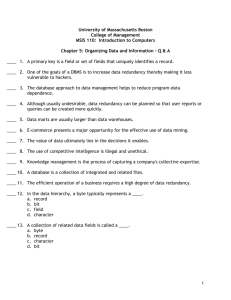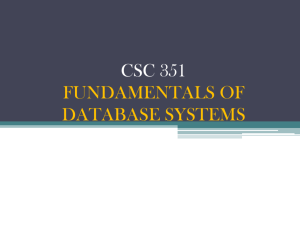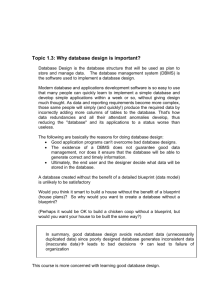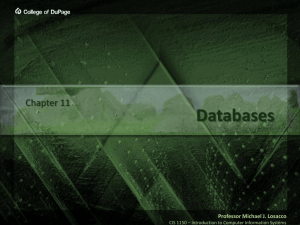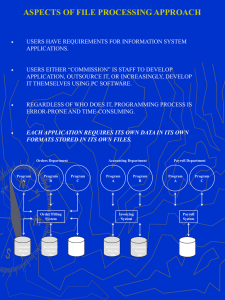Database - siti nurbaya ismail
advertisement
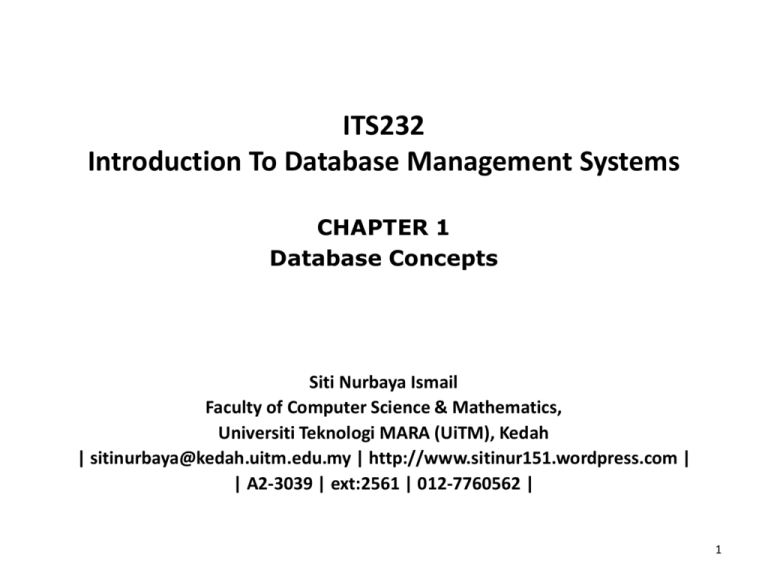
ITS232 Introduction To Database Management Systems CHAPTER 1 Database Concepts Siti Nurbaya Ismail Faculty of Computer Science & Mathematics, Universiti Teknologi MARA (UiTM), Kedah | sitinurbaya@kedah.uitm.edu.my | http://www.sitinur151.wordpress.com | | A2-3039 | ext:2561 | 012-7760562 | 1 Chapter 1: Database Concepts 1.0 Database Concepts 1.1 Introducing The Database 1.2 The Historical Roots Of Database 1.3 Files And File Systems 1.4 A File System Critique 1.5 Database Systems 1.6 Database Models 2 1.1 Introducing The Database 1.1.1 Data and information Data? – Raw facts – Building blocks of information – Examples: • NURUL JANNAH ALI • 2009256966 • CS113 3 1.1 Introducing The Database 1.1.1 Data and information Information? – Produce by processing data – Reveal meaning of data – Examples: • 2009256996 is NURUL JANNAH ALI UiTM Metrics Number and currently she is studying in CS113 Program at UiTM Kedah 4 1.1 Introducing The Database 1.1.1 Data and information How do data and information relate? 5 1.1 Introducing The Database A Glance of Database Concept subject student register subjectno description registerID subjectNO matrixNO matrixNO name ITS232 Database 123 ITS232 2009451782 2009292768 Jefry BEL123 Literature 124 ITS232 2009631908 2009631908 Farah 2009451782 Thohier 6 1.1 Introducing The Database 1.1.2 What is database? Database A shared collection of integrated computer structure designed to meet various needs of an organization. – It houses: • End-user-data : raw facts • Metadata : data about data DBMS DataBase Management System A software that enable user to define, create, maintain and control access to database – – – Possible to share data among multiple applications or users Makes data management more efficient and effective Examples: • IBM DB2, MS Access, MySQL, ORACLE 7 1.1 Introducing The Database 1.1.2 What is database? Create Database Retrieve Data DBMS Create Forms allows Sort Data Create Reports 8 1.1 Introducing The Database 1.1.2 What is database? The importance of database: Manage interactions between end users and database Helps make data management more efficient and effective Its query languages allows make quick answers to add-hoc queries Provide end users better access to more and better managed data Promote and integrated view of org’ operations big picture 9 1.1 Introducing The Database 1.1.2 What is database? Advantages of database: control of data redundancy data consistency more information from the same amount of data sharing of data improved data integrity improved security enforcement of standards economy of scale improved data accessibility and responsiveness increased productivity improved maintenance through data independence improved backup and recovery services 10 1.1 Introducing The Database 1.1.2 What is database? Disadvantages of database: complexity size (space) cost of DBMS additional hardware cost cost of conversion performance higher impact of failure 11 1.1 Introducing The Database 1.1.3 Types of database Database can be classifieds into three types, they are: Classified by number of user Classified by used Classified by locations 12 1.1 Introducing The Database 1.1.3 Types of database Types 1: Classified by number of user • Single-user • Supports only one user at a time • Desktop • Single user database, running on a personal computer • Multi-user • Supports multiple user at one time • Workgroup • supports a small group of user on a single department • Enterprise • supports a large group of users on entire organization 13 1.1 Introducing The Database 1.1.3 Types of database Types 2: Classified by used • Transactional / Production • Support immediate responses transaction • Company day-to-day transaction • Data warehouse • Stores data used to generate information required to make tactical or strategic decisions • Often used to store historical data • Provided by decisions support system (DSS), data massaging (data manipulation) to extract information from historical data • Data warehouse describe dB design by DSS 14 1.1 Introducing The Database 1.1.3 Types of database Types 3: Classified by locations • Centralized dB • DBMS that supports a database located at a single site • Distributed dB • DBMS that supports a database distributed across several different sites 15 1.1 Introducing The Database 1.1.4 Why db are valuable assets for decision making? Basically, database stored data, process data into information as needed by end-user (company) Accurate, relevant, and timely information is key to good decision making Good decision making is the key to survival in a global environment 16 1.1 Introducing The Database 1.1.5 The importance of database design Defines the database’s expected use Different approach needed for different types of databases Avoid redundant data Poorly designed database generates errors leads to bad decisions can lead to failure of organization 17 1.2 Historical Roots of Database 1.2.1 How modern database evolved from file systems Managing data with file systems is obsolete Understanding file system characteristics makes database design easier to understand Awareness of problems with file systems helps prevent similar problems in DBMS Knowledge of file systems is helpful if you plan to convert an obsolete file system to a DBMS 18 1.3 Files and File Systems 1.3.1 Files / Manual File Systems Collection of file folders kept in file cabinet Organization within folders based on data’s expected use (ideally logically related) System adequate for small amounts of data with few reporting requirements Finding and using data in growing collections of file folders became time-consuming and cumbersome 19 1.3 Files and File Systems 1.3.2 File Systems / File-Based-Systems Conversion from manual to computer system A collection of application programs that perform services for the end-users. Could be technically complex, requiring hiring of data processing (DP) specialists 20 1.3 Files and File Systems 1.3.2 File Systems / File-Based-Systems A collection of application programs that perform services for the end-users Each programs manages its own data Data entry and reports Sales files File defination Sales application Sales application programs programs Data entry and reports Contracts files File handling routines Sales File handling routines File defination Sales application programs Contracts application programs Contracts 21 1.3 Files and File Systems 1.3.2 File Systems / File-Based-Systems 22 1.3 Files and File Systems 1.3.2 File Systems / File-Based-Systems As number of databases increased, small file system evolved Each file used its own application programs Each file was owned by individual or department who commissioned its creation 23 1.3 Files and File Systems 1.3.2 File Systems / File-Based-Systems As system grew, demand for DP’s programming skills grew Additional programmers hired DP specialist evolved into DP manager, supervising a DP department Primary activity of department (and DP manager) remained programming 24 1.4 A File System Critique 1.4.1 About Flaws in File System Data Management Every task requires extensive programming in a third-generation language (3GL) • Programmer must specify task and how it must be done Modern databases use fourth-generation languages (4GL) • Allow users to specify what must be done without specifying how it is to be done 25 1.4 A File System Critique 1.4.1 About Flaws in File System Data Management Time-consuming, high-level activity As number of files expands, system administration becomes difficult Making changes in existing file structure is difficult File structure changes require modifications in all programs that use data in that file Modifications are likely to produce errors, requiring additional time to “debug” the program Security features hard to program and therefore often omitted 26 1.4 A File System Critique 1.4.2 Structural and Data Dependence Structural dependence – Access to a file depends on its structure Data dependence – Changes in the data storage characteristics without affecting the application program’s ability to access the data – Logical data format • How the human being views the data – Physical data format • How the computer “sees” the data 27 1.4 A File System Critique 1.4.3 Field Definitions and Naming Conventions Flexible record definition anticipates reporting requirements by breaking up fields into their component parts 28 1.4 A File System Critique 1.4.4 Data Redundancy Data redundancy – same data are stored in many different locations Data inconsistency – Different and conflicting versions of the same data appear in different places – Island of Information – scattered data locations Errors more likely to occur when complex Data redundancy results in data inconsistency Errors more likely to occur when complex entries are made in several different files and/or recur frequently in one or more files Data anomalies develop when required changes in redundant data are not made successfully 29 1.4 A File System Critique 1.4.4 Data Redundancy Data anomalies – Abnormality – Fosters an abnormal condition by forcing field value changes in many different locations – Types of anomalies: • Modification anomalies – Occur when changes must be made to existing records • Insertion anomalies – Occur when entering new records • Deletion anomalies – Occur when deleting records 30 1.5 Database System 1.5.1 Database System Problems inherent in file systems make using a database system desirable – File system • Many separate and unrelated files – Database • Logically related data stored in a single logical data repository 31 1.5 Database System 1.5.1 Database System Database Management System (DBMS) – A software that enable user to define, create, maintain and control access to database – software that interacts with the end user application program and database. • manage dB structure • controls access to data • contains query languages Database – A shared collection of integrated computer structure designed to meet various needs of an organization 32 1.5 Database System 1.5.1 Database System Each program shared same data for different user views Data are save in database and managed by DBMS Database System File details + file definitions Data entry and reports DBMS Database Salesapplication application Sales programs programs Sales Data entry and reports Contracts application Sales application programs programs Contracts 33 1.5 Database System 1.5.2: Database System Component an organizations of component that define and regulate the collection, storage, management and use of data within a database environment. components of a database system: data hardware software procedure people bridge machine components human components 34 1.5 Database System 1.5.2: Database System Component Hardware – Particular hardware depends on org requirements and DBMS model – PC, Web Server, Mainframe Software – dB s/w itself – IBM DB2, Access, MS SQL, Oracle Data – Collections of facts stored in the dB – Acts as a bridge – combine machine components & human components – Operational data and metadada – System catalog 35 1.5 Database System 1.5.2: Database System Component Procedure – Instructions and rules that govern design and use of the system Human – People involve in the system • System administrator • Database administrator (DBAs) • Database designers • System analysts and programmers • End users 36 1.5 Database System 1.5.3 The Different Between Database and File System Database Management Systems (DBMS) – a software system that enables user to define, create, maintain and control access to database. – software that interacts with the end user application program and database. • manage dB structure • controls access to data • contains query languages 37 1.5 Database System 1.5.3 The Different Between Database and File System File System Data entry and reports Sales files Database System File handling routines File defination Sales application programs Sales application programs Data entry and reports Contracts files Database Sales File details + file definitions File handling routines DBMS File defination Sales application programs Contracts application programs Data entry and reports Contracts Database Sales Salesapplication application programs programs Sales Data entry and reports Sales application Contracts application programs programs Contracts 38 1.5 Database System 1.5.3 The Different Between Database and File System A Database System A File System 39 1.5 Database System 1.5.4 DBMS Functions DBMS performs functions that guarantee integrity and consistency of data – Data dictionary management • defines data elements and their relationships – Data storage management • stores data and related data entry forms, report definitions, etc. – Data transformation and presentation • translates logical requests into commands to physically locate and retrieve the requested data – Security management • enforces user security and data privacy within database 40 1.5 Database System 1.5.4 DBMS Functions – Multi-user access control • uses sophisticated algorithms to ensure multiple users can access the database concurrently without compromising the integrity of the database – Backup and recovery management • provides backup and data recovery procedures – Data integrity management • promotes and enforces integrity rules – Database access languages and application programming interfaces • provide data access through a query language – Database communication interfaces • allow database to accept end-user requests via multiple, different network environments 41 1.5 Database Model 1.5.4 Database Model Hierarchical Database Model • Represented by a group of records that relates to each others by a pointer Network Database Model • Based on set theory, a set consists a collection of records Relational Database Model • Based on the mathematical concept of relational Object-Oriented Model • Based on object oriented concepts 42 Summary Data raw facts Information Database DBMS reveal meaning of data shared collection of integrated computer structure designed to meet various needs of organization a software to implement and used database 43 Summary Database design defines the database structure. A well-designed database facilitates data management and generates accurate and valuable information. A poorly designed database can lead to bad decision making, and bad decision making can lead to the failure of an organization. Databases were preceded by file systems. Limitations of file system data management: – – – – – requires extensive programming system administration complex and difficult making changes to existing structures is difficult security features are likely to be inadequate independent files tend to contain redundant data DBMS’s were developed to address file systems’ inherent weaknesses 44 Exercise 1 What is data redundancy and which characteristics of the file system can lead to it ? Explain the difference between data and information. What is the role of a DBMS, and what are its advantages? Exercise 2 What is data independence, and why is it important? Discuss the different between file based system and database system. What are the main components of a database system environment? Exercise 3 1. How many records does the file contain, and how many fields are there per record ? 2. What problem would you encounter if you wanted to produce a listing by city? How would you solve this problem by altering the file structure? 3. What data redundancies do you detect, and how could these redundancies lead to anomalies?


